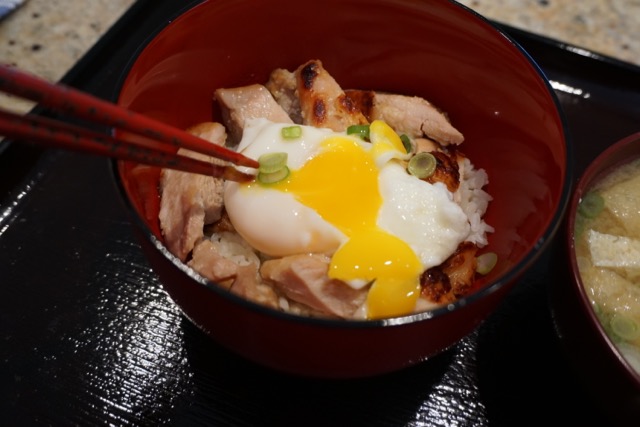Oyako-donburi 親子丼 or what is referred to as parent-and-offspring bowl is a classic dish in which chicken meat is cooked in seasoned broth with beaten eggs added and placed on top of cooked rice. The eggs should be semi-cooked (most recipes call for adding beaten eggs in two stages). Although I like it this way, my wife does not like under-cooked egg whites which she thinks gives the dish a slimy texture. When I saw
this recipe for chicken steak and raw egg over rice (also known as "TKG"
Tamago-Kake-Gohan 卵かけ御飯), I made a TKG version based on this recipe using a raw egg and, another version as per my wife's advice, using a Poached Egg on Rice ("PEoR").
The below is the TKG version. I also made a seasoned broth (see below) and moisten the rice with it. The
chicken thigh was marinated in shio-koji 塩麹. The raw egg is, of course,
pasteurized Davidson's egg.
I beat the egg well with a bit of soy sauce and poured it over the rice and garnished with thinly sliced scallion (I forgot take the final picture).
This is the soft poached egg version. I cooked the egg as
I posted before with the yolk still runny.
My wife used her chopsticks to demonstrate the texture of the yolk for me.
This was a weekend lunch and I also made miso soup with silken tofu, abura-age (fried tofu pouch) and scallion.
I really enjoyed the soup and even my wife finished it (which is unusual).
Ingredients (for four):
Chicken thighs, 4, deboned and excess skin and fat removed, marinated in shio-koji overnight (marination optional).
Eggs, four, Davidson's pasteurized or other salmonela-safe eggs, either poached or beaten with a bit of soy sauce.
Scallion, 4, thinly sliced
Seasoning broth, made of Japanese dashi broth (I used a dashi pack with bonito, kelp and "iriko" dried fish) and concentrated mentsuyu (or mixture of soys sauce and mirin) about 1:1 ratio warmed.
Directions:
I cooked the chicken thighs with the skin side down on low heat without oil in a non-stick frying pan. I cooked them for over 15 minutes occasionally mopping up the fat rendered from the chicken using a paper towel.
Using a plastic or silicon spatula I carefully removed the chicken and turned them over (because of the shio-koji, the skin tended to stick).
I let it cook for 5 minutes and turned off the flame and let it sit for another 10 minutes to complete the cooking.
I put cooked rice in a bowl and moistened it with the seasoning broth, placed the chicken cut into strips on top of the rice. For the TKG version, I then poured beaten raw egg seasoned with soy sauce over the chicken. For the poached egg version, I placed the soft poached egg on the top. I garnished both with thinly sliced scallion. I knew my wife would need more broth so I served a bit extra in a separate bowl. She added more broth to her rice but mine was Ok. We liked this version of Oyako-don very much. Of course, TKG version has a slightly slimy texture from the egg white which was mixed with the rice but I enjoyed it. I do not even remember when the last time I had TKG. The PEoR version was excellent with silky yolk. The small pieces of cooked egg white mixed in added some nice texture to the rice. The chicken was tender and also had good texture. The skin did not really get crispy, unfortunately but had good flavor. Overall, we liked these two versions better than the classic.
The silken tofu is from our regular grocery store. According to the advertisement on the package it was mostly sold to make "smoothies" but, to me, among other tofu such as "firm" or "Extra-firm" versions sold, this is the best to use in miso soup like the one we had.


































